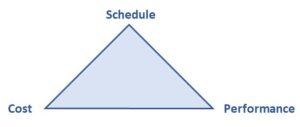Management: Overview
Proposal management is a subset of project management, with that classic triangle.

Push on any corner and the other two move, yeah? In Proposal Land, however, there is an immovable corner: schedule. Everything is affected by having to meet a hard deadline. In that environment, it’s easy for costs to escalate and standards to slide. The management task is to prevent that — to control cost and to maintain standards — while holding to schedule.
Managing the proposal team
It’s not enough to manage just the pursuit — the sales activity — and the production work. Between those two ends of the process, there’s a whack of work to be done to develop a solution tailored for the client and then to create a compliant, compelling, and on-time proposal, and it takes all the management skill available. And then some. Start by looking at the tasks to be completed.
Then consider that the management structures and implicit understandings that get most of us through a work day aren’t usually in place for a proposal team, and must be developed and communicated:
- Organizational structure
- Responsibilities
- Work hours
- Workflow
- Group norms
So get going. And try to think outside whatever box you’re in:
- Frontline supervisors – Think more like a senior manager: Put less focus on the detail, more focus on the risk.
- Senior managers – Think more like a frontline supervisor: Give more hands-on supervision than you’re used to. After all, there isn’t much time to recover from errors and missteps.
Managing submission mandatories
First, what are we even talking about?
Submission mandatories are documents
that must be presented in the correct format
and in the expected place within the proposal,
or conditions that must be met,
for the proposal to proceed to the technical evaluation stage.
That’s a formal way of saying it. Try this.
The client wants some stuff with your proposal.
If you mess up, your proposal gets bounced.No questions. No appeals. No second chances.
Start by checking out the list of documents and conditions, so you know what sort of thing you’re looking for when you read the RFP.
The good news? The trend in Canadian government contracting, at least, has been to simpler, less onerous and mindless, and fewer submission mandatories.
The better news? There’s a proven, tried-and-tested, fail-safe (well, almost) process to manage submission mandatories. And it’s pretty dagnabbed simple. So just do it.
Managing the writers or managing a volume
Although there isn’t always more than one volume, there should always be an operational- or technical-manager type overseeing what the writers are writing, as they’re doing it. Here are the basics:
- Start by understanding both the Work and the response instructions.
- Figure out who needs to talk together to coordinate their sections.
- Know what the plan is for doing the Work so you can make sure that everyone is writing to the same plan.
- Monitor what people are writing even before it gets to the editing stage.
Wanna go beyond that? With the editor(s), figure out which topics/concepts/approaches/solutions need to be consistent across many sections. What kind of things?
- Overarching plans – Think quality, health & safety, risk management.
- Overarching positions – Think camp managers, project managers, staff roles like quality and safety.
- Overarching tools – Think work-management and reporting software, and communication systems.
Then get those topics/concepts/approaches/solutions written early, so the writers can use them, rather than making up their own answers. Not that I’ve ever seen that happen . . .
Managing the subcontractors
For many non-nefarious reasons (and a few self-serving ones), subcontractors complicate proposal management by an order of magnitude. Don’t just wait for whatever they give you: Put someone on the task of managing them. Someone who will:
- Communicate your proposal requirements clearly (words and costs).
- Insist on early review of their input, so there’s time to go back and get better.
Whenever possible, get direct access to the subcontractor’s technical experts. Don’t hobble yourself (and waste time) by having to go through one of their salespeople or managers.
Managing the graphics
Graphics. Add. Value. Because people get tired of reading and pages without pictures are boring.
Graphics. Take. Longer. Longer than what? Longer than you can imagine, unless you’ve actually done the hands-on work yourself, recently. Why? Because they have a visual/artistic component as well as a technical component.
So start early and get input from everyone who will care (and EVERYONE will care, even/especially the executives):
- Graphics you’re going to need/want – Think organization charts, flowcharts, tables, photos, IT wiring diagrams, and conceptual graphics (like everything in quality).
- Graphics standards – Think colour/color palette, font types and sizes, numbering/naming protocols, resolutions, and software.
Once the decisions are made, get going. Graphics. Take. Longer.
Managing the proposal schedule
Every RFP sets its own response schedule, but six weeks isn’t unusual for a large but not humongous government contract, so there’s a sample six-week schedule here. Go ahead and make it your own.
And a final check . . .
On a six-week proposal, how will you know you’re in schedule trouble?
| At this time… | You’re in trouble if…. |
| When the RFP is issued |
|
| At the end of week 2 |
|
| At the end of week 4 |
|
| At the end of week 5 |
|
